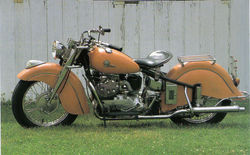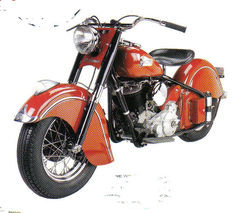INDIAN - THE LEGEND:
The Legend Lives On:
From 1901 till today, Indian has not only been an interesting morotcycle company, but one which never seems to die. The history can be divided into five core historical periods. From 1901 to 1953(the original Indians), 1953 to 1960(British Indian's), from 1967 to the 1970's(the Clymer and mini-bike era), from 1999 to 2006(Indian's from the Gilroy & Stellicon eras), and finally from 2011 and forward(Indian's true second-birth, the Polaris era). The faithful don't fully recognize Indians past the 1901-1953 era, but the post 1953 motorcycles are still branded Indian and have an interesting history. There have been other Indians such as the European "four," as well as several attempted upstarts which failed, however, the five periods mentioned are the basic framework around Indian motorcycle history. Whatever your view, Indian still continues under the management of Polaris Industries today! So here we begin our study of this historic brand with all it's variations. Big news came in summer 2014 with the return of the Scout. The Indian Motorcycle continues.
At the top of the page are the page icons, please use them or use the following links:
Periods of Indian history: www.markbayerindian.mysite.com/photo2.html
Indian Prototypes: www.markbayerindian.mysite.com/custom.html
Worlds Fastest Indian: www.markbayerindian.mysite.com/photo2_1.html
Indian since 1999: www.markbayerindian.mysite.com/custom2.html
Indian Since 2011: www.markbayerindian.mysite.com/photo3_1.html
Polaris Indian: www.markbayerindian.mysite.com/custom_1.html
Great Indian Pictures: www.markbayerindian.mysite.com/photo3.html
Indian timeline: www.markbayerindian.mysite.com/custom_2.html
Indian Fours: www.markbayerindian.mysite.com/custom_3.html
THE BASIC OUTLINE OF INDIAN HISTORY:
Part 1, the Original Indian:
George Hendee and Oscar Hedstrom began the collaboration on the Indian Motorcycle as early as 1898. Hendee was a bicycle builder and bicycle racer, Hedstrom an engineering type. Oscar Hedstrom was the primary builder and Hendee the financial person. The Indian was first offered for sale to the public in 1901and was one of the first motorcycles manufactured in volume. Volume was low, but represented a significant invention which was to become a major part of American culture. In 1901, 3 Indians were sold, in 1902, 143 sold, and in 1902, 376 were built and sold. After 1905, the numbers grew substantially. The first period of Indian history begins with these two men from 1901 to 1929. Paul duPont buys a controlling interest in Indian and operates the company till 1945. Ralph P. Rogers takes control of the company after WWII till 1953.
Part 2, Only the name remains:
After 1953, the British company Brockhouse Engineering takes over management. Brockhouse was the distributor for Matchless, AJS, Norton, Royal Enfield, and Vincent. Many of the Indian dealerships were used to sell these British motorcycles. Brockhouse turns leadership over to Associated Motorcycles (Norton, villiers, and Triumph motorcycles) from about 1959 to 1962. By that time, Associated Motorcycles was nearly bankrupt and many of the former Indian dealerships had either closed their doors or had begun selling other brands. From 1955 till around 1959, some models of the Royal Enfield motorcycles were badged Indian. This angered many old time Indian riders and did little to attract new buyers.
Part 3, The Indian name attached to a variety of different motorcycles:
As early as 1967, Floyd Clymer, an old motorcycle racer, promoter, dealership owner, and magazine owner (Cycle) purchased the Indian name and began to develop a new Indian motorcycle. There are several stories regarding Clymer taking the Indian name. Several stories state that he purchased the name while others claim that he just used it. Probably the most accurate one is that he used the name by claiming that it was a dead brand! In 1967, Clymer built an electric motorcycle called the Papoose. In 1969, Clymer attempted to resurrect the Indian Scout. After 1969, Clymer built several Indian models. Using various Italian and British parts along with British Velocette single cylinder engine, Clymer produced a 500cc sport bike. He also built a larger model using the Royal Enfield twin cylinder engine. There were fewer than 250 of these bikes ever built. Mr. clymer also sold some mini-bikes with the Indian name. They were Indian badged Italian mopeds. Climer died in 1970, stalling any progress in his new line of motorcycles. Clymers wife sells the rights to the Indian name to Alan Newman who then attached the name to imported 2 stroke machines. They were branded Taiwan and Ital-Jet motorcycles sold from 1971 to 1976. Newman goes bankrupt and another company, AMP (American Moped Associates) buys the name and attaches it to small mopeds made in China. AMP sold bikes with the Indian name from 1977 to 1982. AMP then sells the name to Carmen Deleone who attached the name to Derbi motorcycles but has little success. Derbi is an inexpensive motorcycle made in Spain which is associated with Piaggio mopeds. The Derbi Indian lasted less than two years ending in failure by 1984. The name was passed around and was occasionally owned by competing groups. The glory days were long gone.
Part 4, the Gilroy Indian:
In 1999, a Canadian investment group buys the Indian name, then buys a small motorcycle factory in Gilroy, California. They begin to build "kit bikes" labeled Indian. Using commercially available parts along with an S&S engine, Indian rises again. The new Indian company made every effort to develop an "original" Indian. In 2002, they offered their own in house engine. This engine unit was called the Powerplus and was used only in the Chief. They continued to offer a Scout version using the previous S&S powerplant. In all fairness, there have been many companies which built their own brand of motorcycles using many commercially available parts. The new motorcycle was somewhat successful in terms of sales and recognition. Things were developing till late 2003 when a large investor backed out again leaving Indian in bankruptcy court. There had been complaints that the new Indian was not refined and that the dealership network was not strong(compared to other brands). On the plus side, however, the Indian name did begin to find it's place in the motorcycle community. Sales were growing and it was evident that the new company could have been a success with just a little more money, technical development, and a stronger dealership network. The brand had died again till the British company Stellicon Limited purchased the rights to the name.
Part 5, the refined and resurrected Indian:
In 2006, Stellicon Limited, a company known for rebuilding dead companies, began to rebuild the Indian motorcycle. They built a new factory in Kings Mountain, North Carolina and preceeded to spend millions on developing the Gilroy Indian. The 100 cubic inch Powerplus was made larger (105 cu. in.) and was developed and refined to a much greater degree. By paying heafty amounts of money to Harley Davidson development engineers to come over to Indian, they built a staff of men who could make the Indian competitive with other large cruisers. In 2009, the first new Indians were offered for sale in very limited numbers. The new base price was over $30,000+ which was substantially more than its competitors. With few new dealerships opening and sales numbers very small, the brand continued but at a very slow pace. With a significant drop in the economy during 2008, motorcycle sales dropped over 30%. In 2009, motorcycle sales continued to decline even more, bringing into question the ability of Stellicon to continue financing the new morotcycle company. There was slow growth in the numbers of Indian dealerships but the new company did bring out new models in an attempt to keep the brand fresh. One sales figure claimed that the newest Indian, up to this point was selling less than 300 motorcycles per year. As a bit of a surprise, it was announced in May of 2011, that Polaris, the manufacturer of Victory Motorcycles has purchased Indian for an undisclosed amount of money. During 2011 and 2012, Polaris sold the "Stellicon" Indian through the fewer than a dozen existing Indian dealers.
Part 6, the new Polaris Indian:
In 2013 Indian will sell 25 revised "final edition" indians Chiefs which will be the final 2013 models sold. They will then unveil an entirely new series of Indians for 2014. After selling the 25 2013 Indians, production will then turn to the entirely new 2014 series. All Indians built after August of 2013 will be the new 2014 model. According to Polaris, the new 2014 series Indian were not a revised Victory model as many thought would happen, but will offer a new historically relevant and modern motorcycle. Hopefully this incarnation of the 112 year old brand will be fully resurrected! The new 2014 Indians had an entirely new 111cu. in. engine as well as other Indian only components. The new motorcycle was officially released in August of 2013 at the annual Sturgis South Dakota motorcycle rally. The big plans since their release is getting a dealership network set up. I heard through some publication, that Indian was pushing for over 100 new dealers within their first year of production. I am sure this was goal was met. As the 2014 Indian has been viewed and tested, results confirm that Polaris has done some serious design work and has built a competitive motorcycle worthy of the name. The new water cooled Scout came in 2015 and the competitively priced Scout "60" was intoduced as a 2016 model. In 2018 the Scout Bobber was introduced and in 2019, the 1200cc (120 hp)FTR was introduced. The FTR copies the flat trackers which are winning all the races. Indian is the hot one!
The Indian Model 841(1941), pictured above, was designed as a military bike. Few survive. This one has been modified to look like a cruiser!
Pictured below is a 1953 Chief with a rare solo saddle. The 1953 model was the last of the great line of original Indians. After 1953, numerous promoters and companies have used the name, legal or otherwise, to attempt to revive the brand. The best chance of having an "Indian" revival currently exist with Polaris owning the name!
The Indian 841:
At the top of the page is a picture of a civilianized Indian 841. The Indian 841 was a motorcycle developed for the military around 1941. It used Scout heads in a transverse "V" position. The idea was to increase the cooling ability of the cylinders by putting them out in the air stream. The design was copied "conceptually" from the BMW R71, according to some historians. After Harley Davidson and Indian gave test bikes to the military, they chose the Jeep over the 2 wheeled counterpart. Some argue that MotoGuzzi ultimatly copied the 841 in the 1960's when they created their "V" series. The 841 was also shaft driven and had a foot gear shifter, both more modern innovations. After the military turned down the bike for production it was not developed much beyond the original version. They were said to produce only about 25 horse power and were heavy, so were not great performers. Indian produced about 1,050 841's and they are very collectable today. I had read that there were only about 300 known to exist today.
Below is a link to my motorcycle history web site, click and study:
Go to the bottom of the"Beyond 2013" page for Indian motorcycle web sites!
Also check out the links at: www.markbayermotorcycles.mysite.com
Bolow is my e-mail link:

